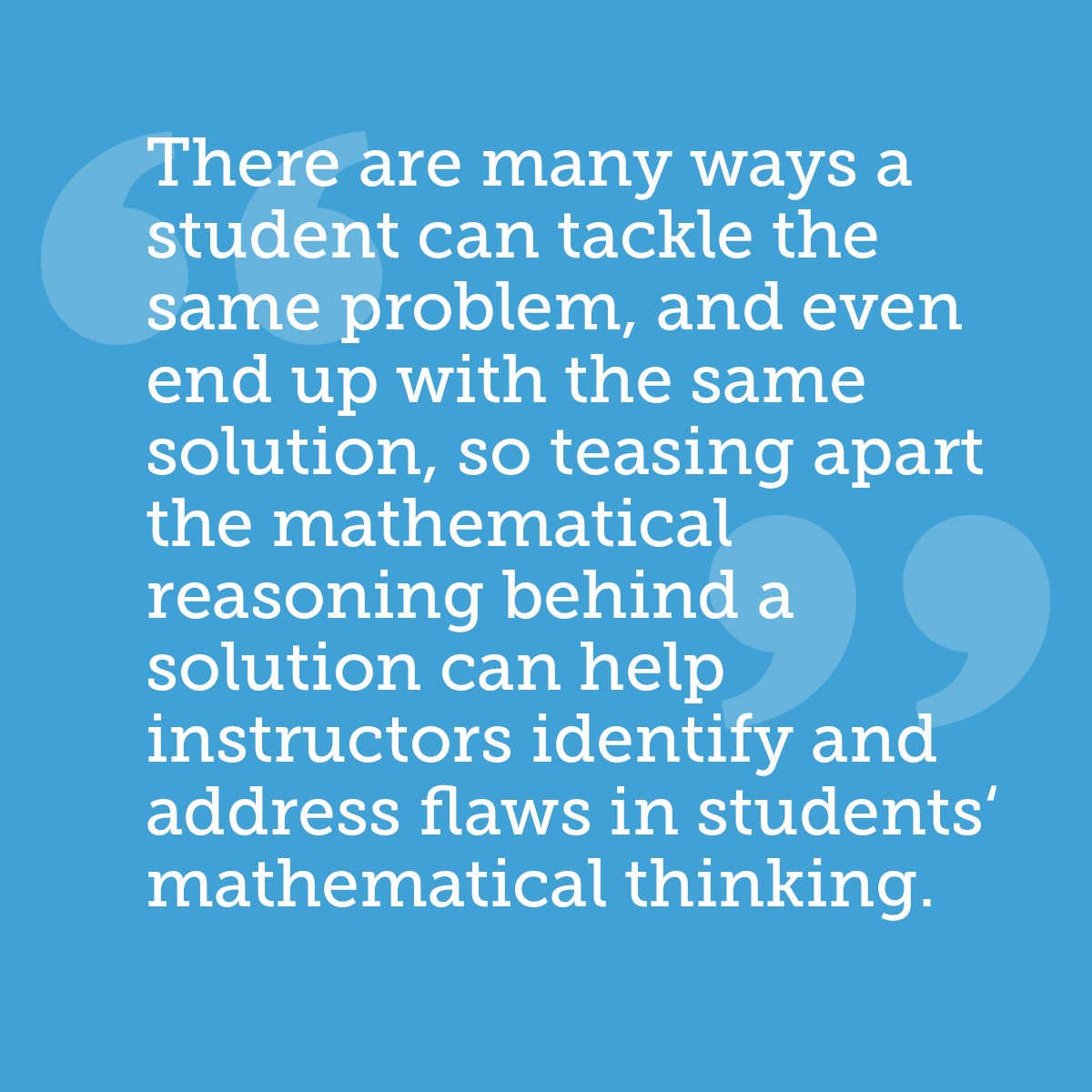
How do children develop an understanding of math concepts? How can educators support math learners?
Research suggests that the mind is hard‐wired to view the world numerically.[i] Children begin to understand and use numbers very early in life, and can distinguish between different quantities of objects as early as six months of age.[ii] As they grow, children learn to count, to understand numbers as symbols for representing quantities, to discriminate between different quantities, and to put things in numerical order.[iii] This numerical competence is the foundation for the development of more complex math skills.
Formal math activities like counting and using numbers rely in part on number sense, an innate human awareness of how numbers work. Number sense includes the intuitive ability to distinguish between quantities, understand how numbers are related to each other, and perceive what happens when quantities are combined or separated (i.e. addition and subtraction).[iv] Students typically enter school with a basic number sense that has been forming since infancy. Educators can build on students’ numerical understanding by exploring numbers in a variety of ways in the classroom. For instance, research has shown that playing number board games can help students develop skills including number line estimation, magnitude comparison, numeral identification, and counting.[v]
Of course, math encompasses more than numbers. Children also learn key skills including measurement and comparison, pattern recognition, abstract and symbolic thinking, and spatial reasoning in math class. While abstract math is often seen as advanced subject matter, research has shown that even elementary school students are capable of complex mathematical processes including algebraic thinking.[vi]
The sections below highlight some key findings from the research on the learning and teaching of math.
The most familiar and well-documented math skill that children can learn at a young age is an understanding of numbers. Basic number skills — the understanding of numbers as symbols, the ability to count and put things in numerical order, and the ability to discriminate between different quantities — build the foundation for more advanced math achievement. Children who have strong numerical competence by kindergarten and first grade perform better on standardized math tests later in elementary school.[vii] Those who lack basic number skills can continue to fall behind their peers as they progress through elementary and secondary math classes.[vii] Emerging research is also showing that conceptual aspects of fractions (including equal partitioning or “fair sharing”), algebra, and geometry can be learned in the early grades, which can improve students’ later math performance.[viii]

Spatial ability is the capacity to visualize and mentally manipulate objects; for example, to imagine what an object would look like if it were rotated. Spatial ability plays an important role in math learning, and is a strong predictor of a student’s achievement in math, science, and engineering.[ix] While some people naturally develop strong spatial ability, a large body of research demonstrates that it can also be learned through activities ranging from video games, to blocks and puzzles, to instructor‐led spatial lessons.[x] Spatial training can even improve performance on tasks that are not explicitly spatial.[xi] In one study, for instance, children who received training in the mental rotation of objects performed better on arithmetic exercises than those who did not receive the training.[xii]
There are no innate differences between males and females in mathematical or spatial reasoning abilities.[xiii] However, A recent study showed that male and female 10th grade students had the same confidence in handling tough concepts in English, but boys rated their own ability to tackle the toughest math problems much higher than girls even though they were getting the same grades. Math confidence predicted whether students of both genders persisted in science, technology, engineering or math (STEM) courses in college, but boys with the highest belief in their own math abilities in their senior year of high school had more than three times higher chance of majoring in a STEM field than a similar group of girls.[xiv] Some strategies, including pairing girls with female role models in STEM fields and informal learning activities, like afterschool math clubs and science museum visits, have been effective in increasing female students’ interest, and persistence, in math and other STEM subjects.[xv]
Both children and adults can experience anxiety around math in the classroom as well as the real world.[xvi] Teachers who feel math anxiety can unintentionally pass it on to their students. Research has found a link between teachers’ math anxiety and the math anxiety and math confidence of their students; this link is particularly noticeable in female students.[xvii] Teachers can inadvertently transmit negative attitudes about math either explicitly, by saying that they dislike numbers or that math is hard, or implicitly, by cutting math work short or treating it as a chore to be completed in order to get to more “fun” learning activities. Studies show that training courses on the fundamentals of how to teach math, as opposed to how to do math, can reduce teachers’ math anxiety.[xviii] Research has also found that dialogue around math concepts and discussions of mathematical reasoning in the classroom can reduce students’ math anxiety.[xix] When teachers focus on cultivating positive mathematical mindsets in their students, students understand that they can work hard and improve at math; it is not about innate talent.[xx]
 In the traditional approach to teaching mathematics, often an instructor would pose a math problem, a student would respond, and the instructor would evaluate their solution.[xxi] However, recent research supports a more interactive approach that asks students to explain and elaborate on their mathematical reasoning rather than simply provide an answer or show calculations.[xxii] There are many ways a student can tackle the same problem, and even end up with the same solution,[xxiii] so listening carefully to students’ explanations to tease apart the mathematical reasoning behind a solution can help instructors identify, and directly address, any gaps in students’ mathematical thinking.[xxiv] Observant teachers who attend to the developing ideas of students – by listening, questioning, and building a collaborative community of problem solvers – support meaningful math learning.[xxv]
In the traditional approach to teaching mathematics, often an instructor would pose a math problem, a student would respond, and the instructor would evaluate their solution.[xxi] However, recent research supports a more interactive approach that asks students to explain and elaborate on their mathematical reasoning rather than simply provide an answer or show calculations.[xxii] There are many ways a student can tackle the same problem, and even end up with the same solution,[xxiii] so listening carefully to students’ explanations to tease apart the mathematical reasoning behind a solution can help instructors identify, and directly address, any gaps in students’ mathematical thinking.[xxiv] Observant teachers who attend to the developing ideas of students – by listening, questioning, and building a collaborative community of problem solvers – support meaningful math learning.[xxv]
Explore Math Learning on the Visualization.
Citations
[i]Cantlon JF, Libertus ME, Pinel P, Dehaene S, Brannon EM, Pelphrey KA, (2009). The Neural Development of an Abstract Concept of Number Journal of Cognitive Neuroscience.
[ii] John D.Bransford, Ann L.Brown, and Rodney R.Cocking, editors (2000) How People Learn Brain, Mind, Experience, and School. Chapter 4 — “How Children Learn”
[iii] Siegler, R. S. (2003). Implications of cognitive science research for mathematics education. In Kilpatrick, J., Martin, W. B., & Schifter, D. E. (Eds.), A research companion to principles and standards for school mathematics (pp. 219‐233). Reston, VA: National Council of Teachers of Mathematics.
[iv] Jordan, N. C., Glutting, J., Ramineni, C., & Watkins, M. W. (2010). Validating a number sense screening tool for use in kindergarten and first grade: Prediction of mathematics proficiency in third grade. School Psychology Review, 39(2), 181.
[v] Ramani, G. B., Siegler, R. S., & Hitti, A. (2012). Taking it to the classroom: Number board games as a small group learning activity. Journal of educational psychology, 104(3), 661.
[vi] Bastable, V., and Schifter, D. (2008). Classroom Stories: Examples of Elementary Students Engaged in Early Algebra. In Kaput, J., Carraher, D., and Blanton, M. (Ed.) Algebra in the Early Grades (165-184). New York: Lawrence Erlbaum Associates and National Council of Teachers of Mathematics.
[vii] Validating a Number Sense Screening Tool for Use in Kindergarten and First Grade: Prediction of Mathematics Proficiency… [Article] Jordan NC, Glutting J, Ramineni C, Watkins MW,SCHOOL PSYCHOL REV (2010)
Cognitive Predictors of Achievement Growth in Mathematics: A 5‐Year Longitudinal Study [Article] Geary DC,DEV PSYCHOL (2011)
[viii] Gearhart, M., Saxe, G., Seltzer, M., Schlackman, J., Ching, C., Nasir, N., . . . Sloan, T. (1999). Opportunities to Learn Fractions in Elementary Mathematics Classrooms. Journal for Research in Mathematics Education, 30(3), 286-315.
Bastable, V., and Schifter, D. (2008). Classroom Stories: Examples of Elementary Students Engaged in Early Algebra. In Kaput, J., Carraher, D., and Blanton, M. (Ed.) Algebra in the Early Grades (165-184). New York: Lawrence Erlbaum Associates and National Council of Teachers of Mathematics.
[ix] Wai, J., Lubinski, D., & Benbow, C. P. (2009). Spatial ability for STEM domains: Aligning over 50 years of cumulative psychological knowledge solidifies its importance. Journal of Educational Psychology, 101(4), 817–835. doi:10.1037/a0016127
Shea, D. L., Lubinski, D., & Benbow, C. P. (2001). Importance of assessing spatial ability in intellectually talented young adolescents: A 20‐year longitudinal study. Journal of Educational Psychology, 93(3), 604–614. doi:10.1037/0022‐0663.93.3.604
[x] Uttal, D. H., Meadow, N. G., Tipton, E., Hand, L. L., Alden, A. R., Warren, C., & Newcombe, N. S. (2013). The malleability of spatial skills: a meta‐analysis of training studies. Psychological bulletin, 139(2), 352.
[xi] Uttal, D. H., Meadow, N. G., Tipton, E., Hand, L. L., Alden, A. R., Warren, C., & Newcombe, N. S. (2013). The malleability of spatial skills: a meta‐analysis of training studies. Psychological bulletin, 139(2), 352.
[xii] Cheng, Y. L., & Mix, K. S. (2014). Spatial training improves children’s mathematics ability. Journal of Cognition and Development, 15(1), 2‐11.
[xiii] Sex differences in intrinsic aptitude for mathematics and science? A critical review [Review] Spelke ES,AM PSYCHOL (2005).
[xiv] Lara Perez-Felkner, L., Nix, S., & Thomas, K. (2017). Gendered Pathways: How Mathematics Ability Beliefs Shape Secondary and Postsecondary Course and Degree Field Choices. Frontiers in Psychology.
[xv] Weber, K. (2011). Role Models and Informal STEM-related Activities Positively Impact Female Interest in STEM. Technology and Engineering Teacher, 71, 18-21.
[xvi] Beilock, S. L., & Willingham, D. T. (2014). Math anxiety: Can teachers help students reduce it? American Educator, Summer: 28-32.
[xvii] Beilock, S. L., Gunderson, E. A., Ramirez, G., & Levine, S. C. (2010). Female teachers’ math anxiety affects girls’ math achievement. Proceedings of the National Academy of Sciences, 107(5): 1860-1863.
[xviii] Beilock, S. L., & Willingham, D. T. (2014).
[xix] Walshaw, M., & Anthony, G. (2008). The teacher’s role in classroom discourse: A review of recent research into mathematics classrooms. Review of educational research, 78(3): 516-551.
[xx] Dweck, C. (2008). Mindsets and Math/Science Achievement. The Carnegie Corporation of New York-Institute for Advanced Study Commission on Mathematics and Science Education.
[xxi] Franke, M. L., Kazemi, E., & Battey, D. (2007). Mathematics teaching and classroom practice. Second handbook of research on mathematics teaching and learning, 1, 225‐256.
[xxii] Franke, M. L., Kazemi, E., & Battey, D. (2007). Mathematics teaching and classroom practice. Second handbook of research on mathematics teaching and learning, 1, 225‐256.
https://www.air.org/sites/default/files/downloads/report/An‐UpClose‐Look‐at‐Student‐Centered‐Math‐Teaching.pdf
[xxiii] Siegler, R. S. (2003). Implications of cognitive science research for mathematics education. In Kilpatrick, J., Martin, W. B., & Schifter, D. E. (Eds.), A research companion to principles and standards for school mathematics (pp. 219‐233). Reston, VA: National Council of Teachers of Mathematics.
[xxiv] https://www.air.org/sites/default/files/downloads/report/An‐UpClose‐Look‐at‐Student‐Centered‐ Math‐Teaching.pdf
[xxv] Mueller, M., Yankelewitz, D. & Maher, C. (2014). Teachers Promoting Student Mathematical Reasoning. Investigations in Mathematics Learning, 7(2), 1-20.